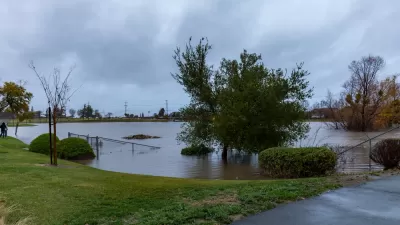The Net Zero Water Toolkit helps individuals and organizations make water resource planning decisions based on local conditions rather than targeting historical demand and allowing water quality impacts to flow downstream.
Building off the principles of net zero energy and climate neutrality, Net Zero Water (NZW) is concept that aims to change the way water resources are managed by making water resource planning decisions based on local conditions. Rather than going out and securing water supplies to meet historical demand patterns, a net zero water approach looks at local precipitation patterns and tries to maintain consumption at or below that available local supply. And, rather than allowing water quality impacts from stormwater runoff in developed areas to flow downstream, a net zero water approach looks to treat runoff on-site. NZW, or being water neutral, means using only as much water as falls on your site and eliminating all water quality impacts from the site.
To pilot the concept of NZW, Brendle Group (a sustainability engineering and planning firm) led the development of a building-scale NZW Planning Toolkit that walks users through the process of understanding their water footprint and taking action to reduce consumption and improve water quality whether they are a building owner, company, school campus, or community.
To launch this groundbreaking initiative, a user-friendly Microsoft Excel®-based analysis tool and companion guidebook (NZW Planning Toolkit) have been developed with the help of a project team, sponsors, and a technical advisory group. The NZW Planning Toolkit is designed to help users quantify their water footprint, evaluate reduction strategies, and recognize financial and environmental benefits from reducing their water use and water quality impacts. It is anticipated to be used widely across the public and private sectors and is intended to standardize and simplify water analysis and planning, while maximizing economic returns and environmental benefits.
The building-scale Toolkit is currently available for free download. Subsequent phases will focus on modules for the building portfolio, campus, district/neighborhood, and community scales.
FULL STORY: New Zero Water

Planetizen Federal Action Tracker
A weekly monitor of how Trump’s orders and actions are impacting planners and planning in America.

Congressman Proposes Bill to Rename DC Metro “Trump Train”
The Make Autorail Great Again Act would withhold federal funding to the system until the Washington Metropolitan Area Transit Authority (WMATA), rebrands as the Washington Metropolitan Authority for Greater Access (WMAGA).

DARTSpace Platform Streamlines Dallas TOD Application Process
The Dallas transit agency hopes a shorter permitting timeline will boost transit-oriented development around rail stations.

LA County Creating Action Plan to Tackle Extreme Heat
Los Angeles County is creating a Heat Action Plan to help communities stay safe during extreme heat, with steps like adding more shade, improving buildings, and supporting the neighborhoods most at risk.

Maryland Plans Quick-Build Complete Streets Projects
The state will use low-cost interventions to improve road safety in five Maryland counties.

Downtown Los Angeles Gears Up for Growth
A new report highlights Downtown L.A.’s ongoing revival through major housing projects, adaptive reuse, hospitality growth, and preparations for global events in the years ahead.
Urban Design for Planners 1: Software Tools
This six-course series explores essential urban design concepts using open source software and equips planners with the tools they need to participate fully in the urban design process.
Planning for Universal Design
Learn the tools for implementing Universal Design in planning regulations.
City of Charlotte
Municipality of Princeton
Roanoke Valley-Alleghany Regional Commission
City of Camden Redevelopment Agency
City of Astoria
Transportation Research & Education Center (TREC) at Portland State University
US High Speed Rail Association
City of Camden Redevelopment Agency
Municipality of Princeton (NJ)






























